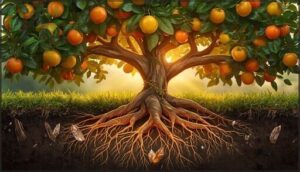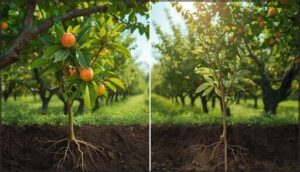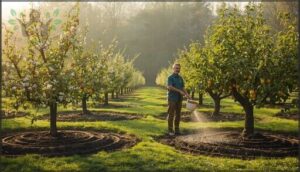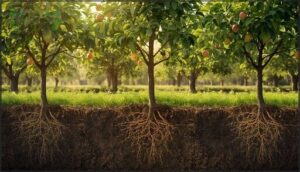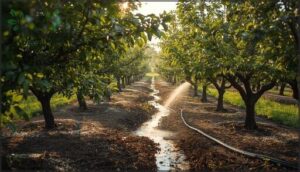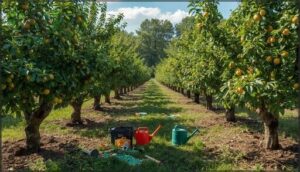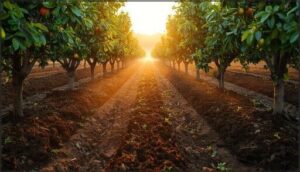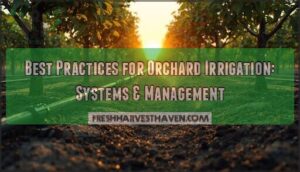This site is supported by our readers. We may earn a commission, at no cost to you, if you purchase through links.
A single season’s worth of fertilizer can nudge a backyard orchard from sparse branches to boughs bent with fruit. For growers, that’s more than luck—it’s technique, science, and a little bit of intuition.
The right nutrients grow fuller harvests and each bite becomes the proof: bigger apples, firmer plums, cherries worth the climb. Fruit tree fertilization tips are the secret to pushing past average yields and coaxing out exceptional flavors.
By learning what your trees crave and spotting the early signs of need, you’ll set up your orchard for years of vigorous, resilient growth.
Table Of Contents
- Key Takeaways
- Why Fertilizing Fruit Trees is Essential
- Key Nutrients Fruit Trees Need
- How to Assess Your Tree’s Fertilizer Needs
- Best Time to Fertilize Fruit Trees
- Choosing The Right Fertilizer Type
- Applying Fertilizer Correctly
- Seasonal Fertilization Guide
- Special Tips for Young Fruit Trees
- Avoiding Common Fertilization Mistakes
- Optimizing Soil Health for Fertilization
- Frequently Asked Questions (FAQs)
- What fertilizers work best for citrus trees?
- How do container fruit trees differ in feeding?
- Can coffee grounds benefit fruit tree health?
- Should newly grafted trees receive special fertilization?
- How does mulching affect fertilizer application schedules?
- Can mulching impact fruit tree fertilization results?
- How does fertilization differ in container-grown fruit trees?
- Are there signs of fertilizer buildup or toxicity?
- What weather conditions affect fertilizer effectiveness?
- How can drip irrigation be combined with fertilization?
- Conclusion
Key Takeaways
- Fertilizing fruit trees at the right times and with the correct nutrients directly boosts yields, fruit size, and overall tree health.
- Regular assessment of tree growth, leaf color, and shoot length helps you spot nutrient needs and adjust fertilizer use before problems begin.
- Choosing fertilizers tailored to your tree’s age, soil type, and local deficiency—balancing nitrogen, phosphorus, potassium, and essential micronutrients—sets the foundation for lasting productivity.
- Over-fertilizing or under-fertilizing can both harm your orchard, so use soil tests and careful application methods to find the sweet spot for steady growth and quality harvests.
Why Fertilizing Fruit Trees is Essential
Fertilizing your fruit trees isn’t just about adding nutrients to the soil—it’s about setting the foundation for strong growth and abundant harvests. When you provide the right nutrients at the right time, you’re directly influencing everything from how well your trees resist disease to the quality of fruit they produce.
Fertilizing fruit trees lays the groundwork for vigorous growth and harvests, directly shaping both their resilience and the quality of their fruit
Let’s look at why proper fertilization makes such a meaningful difference for your trees.
Benefits for Tree Health and Yield
When you give your fruit trees the nutrients they need, you’re investing in results that show up season after season. Proper fertilization directly impacts tree health and fruit production in measurable ways:
- Higher fruit yields: Nitrogen fertilization can increase total fruit production by 30–49% compared with unfertilized trees, with gains sustained across multiple growing seasons.
- Increased fruit size: More than 70% of yield improvements come from commercially valuable large fruits, boosting your harvest’s market quality.
- Improved tree vigor: Adequate fertilization maintains stable canopy development and consistent shoot growth, supporting predictable yields year after year.
These benefits translate to stronger trees that produce more abundant, higher-quality fruit. Organic fertilization can also lead to increased root production.
Role in Pest and Disease Resistance
Proper fertilization strengthens your trees’ natural defenses against pests and diseases. Trees with balanced nutrients show up to 37% fewer pest infestations when you combine nutrient management with integrated pest management strategies.
Nutrient deficiencies weaken disease resistance—potassium shortages reduce defensive compounds, while nitrogen deficits can drop resistance enzyme activity by 30%. Timing matters too: spring applications reduce powdery mildew by 22%, supporting tree health when it counts most.
Selecting well-adapted, resistant varieties is an essential first step in combating pest problems.
Impact on Fruit Size and Quality
Beyond disease protection, fertilization directly affects your harvest quality. Nitrogen at proper levels boosts apple fruit size by up to 16%, though excess drops firmness by 12%. Potassium benefits include better color and fewer defects, while micronutrient roles show dramatic results—foliar applications increased peach diameter and vitamin C by 65%.
Application timing matters: drip fertigation raised citrus soluble solids more than broadcast methods, proving technique shapes taste.
Key Nutrients Fruit Trees Need
Think of nutrients as the building blocks your fruit trees use to grow strong, produce abundant fruit, and stay healthy year after year. Some nutrients are needed in large quantities to fuel major processes like leaf production and root development, while others play smaller but equally important roles in fruit quality and disease resistance.
Your tree’s appetite for these nutrients also shifts as it matures, so understanding what it needs at each stage helps you fertilize more effectively.
Macronutrients: Nitrogen, Phosphorus, Potassium
Your fruit trees rely on three macronutrients to thrive. Nitrogen drives leaf and stem growth, requiring up to 0.88 to 1.43 pounds annually for mature trees. Phosphorus fosters root development and flowering, with deficiencies potentially cutting production by 20%. Potassium enhances fruit quality, color, and shelf life while strengthening disease resistance.
Balanced NPK ratios like 10-10-10 provide all three nutrients efficiently, improving yields considerably when applied correctly.
Important Micronutrients for Fruit Production
While macronutrients grab attention, micronutrients like boron, zinc, manganese, copper, iron, and calcium quietly determine your harvest success.
Boron importance shows during flowering—it improves fruit set and prevents internal browning. Zinc deficiency causes stunted shoots and smaller fruit, while manganese effects include reduced yield and vitamin C content. Copper benefits photosynthesis and stem strength.
Iron impact directly affects fruit size through better chlorophyll production, addressing nutrient deficiency concerns tied to soil pH.
How Nutrient Needs Change With Tree Age
As your tree matures, its appetite for nutrients shifts dramatically—understanding these changes prevents waste and boosts production.
Nutrient priorities evolve through five distinct life stages:
- Early Establishment (years 1-3): Focus on phosphorus for root development, limiting nitrogen to 0.25–0.5 pounds annually to avoid excess vegetative growth in young trees.
- Juvenile Nutrition (years 2-4): Increase nitrogen gradually by 0.01–0.04 pounds per year based on trunk diameter, aiming for 12-inch annual shoot growth.
- Bearing Shift (years 4-5): Shift toward potassium for fruit expansion while capping nitrogen at 1–2 pounds per inch of trunk diameter to balance tree growth with fruit production.
- Mature Trees (6-20 years): Apply 2–3 pounds of balanced fertilizer yearly, adjusting by trunk size, as nutrient needs of fruit trees stabilize during peak bearing.
- Senescent Needs (20+ years): Reduce applications since aging trees rely more on stored reserves than new uptake, preventing unnecessary vegetative regrowth.
Monitor shoot extension—growth exceeding 12 inches signals you’re overdoing fruit tree fertilization.
How to Assess Your Tree’s Fertilizer Needs
Your fruit tree will tell you what it needs if you know what to look for. The signs aren’t always obvious, but a few key indicators can reveal whether your tree is getting enough nutrients or falling short.
We’ll focus on two practical ways to assess your tree’s fertilizer needs: spotting visual symptoms and measuring growth patterns.
Visual Signs of Nutrient Deficiencies
Your tree often tells you what it needs if you know what to look for. Leaf chlorosis—yellowing leaves—signals deficiencies in nitrogen, iron, manganese, or zinc. Nitrogen-starved trees show yellowing in older, lower leaves, while iron issues appear on young growth first.
Watch for stunted growth, smaller leaves, and shortened branches, which point to nitrogen or phosphorus shortages. Necrotic leaves with brown, dying edges suggest potassium or magnesium problems.
Abnormal fruit, like small or misshapen apples, and increased fruit drop often indicate boron or potassium deficiencies.
Evaluating New Shoot Growth
Healthy shoot growth reveals whether your tree is getting enough nutrients. You’re looking for new shoots extending 8 to 12 inches by midsummer—a sign of nutrient sufficiency and balanced fruit load.
Shoots shorter than 6 inches, especially with pale leaves, suggest nutrient deficiencies affecting vegetative growth. Conversely, excessive shoot vigor beyond 18 inches can indicate over-fertilization.
Evaluating shoot growth alongside leaf area and overall leaf growth gives you a reliable picture of your tree’s nutritional status, helping you adjust fertilization before problems escalate. Growth influences vary, but consistent shoot length tells the story.
Best Time to Fertilize Fruit Trees
Timing isn’t just important for fertilizing fruit trees—it’s everything. Apply nutrients when your trees can actually use them, and you’ll see stronger growth, better blooms, and healthier fruit.
Let’s look at the key windows throughout the year when fertilization makes the biggest difference.
Spring Fertilization for Growth and Bloom
Timing is essential for spring fertilization. Apply your fertilizer between April and mid-May, right before bud break, to fuel early growth and flowering. Nitrogen is critical here—it aids bloom development by complementing nutrient remobilization from the tree’s reserves.
For stone fruits, split applications work best: one in mid-late April, another in late May, ensuring steady uptake as soil temperature rises.
Summer Feeding for Fruit Development
Once your tree has set fruit, summer feeding shifts focus to developing size, sweetness, and firmness. You’ll want to reduce nitrogen after July—late applications can stimulate tender growth vulnerable to frost. Instead, fertilize fruit trees with potassium for sweetness and calcium for firmness during post-flowering stages. Here’s how to improve fruit quality through strategic summer application methods:
- Potassium sulfate boosts sugar content and improves flavor
- Calcium nitrate strengthens cell walls, reducing bruising
- Boron supplementation prevents physiological disorders during fruit development
- Apply fertilizer around the drip line, then water deeply
- Watch for signs of over-fertilization—yellowing leaves or soft fruit
Mitigating over-fertilization protects both fruit quality and tree health.
Fall and Late Winter Fertilization Strategies
As fruit ripens and leaves begin to fall, your focus shifts to Dormancy Fertilization. Late October or early November—after a soil test—lets you target Nutrient Storage for spring. This timing boosts Disease Resistance, root health, and winter hardiness, but avoid excess nitrogen to reduce Frost Susceptibility.
Here’s a quick reference:
| Strategy | Benefit | Risk |
|---|---|---|
| Soil testing | Targeted feeding | Missed deficiencies |
| Organic matter | Soil health | Over-application |
| Application timing | Nutrient storage | Dormancy disruption |
Choosing The Right Fertilizer Type
Choosing the right fertilizer can make all the difference for your fruit trees. You have a few reliable options, each with its own strengths.
Let’s take a closer look at what works best.
Balanced Synthetic Fertilizers (e.g., 10-10-10)
A balanced synthetic fertilizer like 10-10-10 delivers even NPK ratios, giving your trees a solid nutritional push. To make the most of it, remember:
- Spread fertilizer evenly beneath the canopy.
- Avoid direct contact with the trunk.
- Watch for signs of nutrient leaching and soil imbalances—overuse brings runoff risks and environmental impact.
Careful fertilization encourages steady, productive growth.
Organic Options: Compost, Manure, Bone Meal
When you want more than a quick fix, organic fertilizer like compost, manure, or bone meal brings steady, soil-deep rewards. Compost’s nutrient content builds soil health, manure offers ample application rates for NPK, and bone meal adds slow-release phosphorus. Each boosts soil microbial activity, supporting trees long after synthetic feeds disappear.
| Organic Option | Key Benefit |
|---|---|
| ————–: | : |
| —————— | |
| Compost | Feeds soil life |
| Manure | Adds ample NPK |
| Bone meal | Long phosphorus feed |
Micronutrient Supplements and Boosters
If you’re searching for a real boost beyond compost or manure, targeted micronutrient application steps in where soils fall short. Addressing nutrient deficiencies with the right dosage rates through foliar sprays—especially chelated forms—can sharpen fruit quality and yield. Always let deficiency diagnosis guide any supplement. Key trace minerals like boron, iron, and zinc influence taste, firmness, and shelf life.
- Spot deficiencies using leaf testing
- Foliar sprays reach leaves fast
- Chelated forms work better in high pH soils
- Stick to recommended dosage rates to avoid toxicity
- Boosts in flavor and vitamin content often follow proper application
Applying Fertilizer Correctly
Getting fertilizer in the right place and in the right amount makes all the difference for your fruit trees. Each method comes with its own benefits and best moments for use.
Let’s look at the main ways to apply fertilizer effectively.
Calculating Proper Amounts for Tree Age and Size
Think of fertilization like tailoring—a precise fit matters. Age-Based Dosage means young trees need about 1/20 lb of nitrogen each year, while Diameter-Based Dosage relies on trunk size for older trees.
Growth Adjustments depend on recent shoot length and signs of nutrient deficiencies. Always consider soil test results and don’t exceed safe maximums, or you risk harming nutrient uptake.
Granular Vs. Liquid Fertilizer Methods
When you fertilize fruit trees, both granular and liquid fertilizer methods have their place. Granular fertilizers offer long release time with fewer applications, making them orchard favorites for steady nutrient uptake and minimal environmental impact.
Liquid fertilizers act fast and must be applied more often, but they’re useful for quick corrections.
Consider your soil, crop needs, and practicality for each fertilizer application.
Topdressing and Foliar Applications
Regarding nutrient delivery, topdressing with compost or organic mulch steadily feeds roots near the soil surface, boosting moisture and root density over time. Foliar spray, by contrast, sends nutrients right to the leaves—especially effective when you need quick corrections.
For the best results, weave both application methods into your fertilizer program to improve yield responses and soil effects.
Watering After Fertilizer Application
After fertilization, water isn’t just a follow-up—it’s the bridge that carries nutrients into the root zone. Apply about 1 to 2 inches of water for proper nutrient uptake, but avoid overwatering, which risks leaching prevention failures.
Timed irrigation right after applying fertilizer helps roots absorb nutrients efficiently, reduces plant stress, and keeps your watering practices in harmony with tree health.
Seasonal Fertilization Guide
Each season brings its own set of needs for feeding your fruit trees. Knowing what to watch for helps you keep your trees healthy and productive all year.
Here’s what to think about as your trees move through the seasons.
Nutrient Needs by Season
Each season brings its own nutrient priorities. Early spring is all about Spring Nitrogen to fuel new shoots, while Summer Potassium aids fruit sizing and resilience through the growing season. Fall Replenishment restores what’s lost, building Winter Reserves before dormancy.
Don’t overlook Uptake Variability—trees absorb nutrients differently year to year, especially when fruit loads swing.
Adjusting Applications for Weather and Growth Stage
Ever noticed how a hot spell or sudden rain can throw your orchard’s rhythm off? Smart growers make weather adjustments by timing feedings for each growth stage: Early Spring, Post-Flowering, and Late Summer.
Using foliar strategies after heavy rain or during drought speeds recovery and improves nutrient efficiency, keeping your fruit trees resilient through the growing season and ready for dormancy.
Split Applications for Sandy Soils
If your trees are rooted in sandy soils, split fertilizer application is your best ally. Rather than dumping all nutrients at once and risking massive leaching, feeding in two equal doses boosts yield, nutrient uptake, and soil benefits.
Timed right—one shot before bud break, another a few weeks later—you’ll minimize waste while supporting steady growth and strong fruit set.
Special Tips for Young Fruit Trees
Caring for young fruit trees takes a careful approach, especially with fertilization. These early years set the stage for strong roots and healthy growth.
Here’s what you need to know to give your trees the best start.
Preparing Planting Holes With Nutrients
Before planting fruit trees, focus on the roots by ensuring the planting hole gets the right start. Perform soil tests for pH and macronutrient levels, then amend with organic matter and needed nutrients based on those results.
Check drainage by filling the hole with water—slow draining calls for further adjustments. This foundation promotes healthy fertilization and strong growth.
First-Year Fertilization Guidelines
Once your planting hole is ready, it’s time to think about first-year fertilization. Keep it light—use a balanced nutrient composition, avoiding high-nitrogen blends that can hinder root establishment.
Apply fertilizer as a topdressing, well away from the trunk, and water it in. Split applications help with sandy soils, but always watch for over-fertilization risks with young fruit trees.
Building Strong Root Systems
Now that you’ve started your trees off right, focus on feeding strong root systems for lasting health. Phosphorus importance can’t be overstated—it fuels early root growth and resilience. Use soil amendments and encourage microbial activity, while managing root hydration and fertilizer placement for steady expansion.
For best results, support healthy roots with these strategies:
- Incorporate compost or biochar
- Foster mycorrhizal fungi
- Maintain soil moisture
- Apply nutrients at the dripline
Avoiding Common Fertilization Mistakes
Even with the best intentions, it’s easy to make mistakes when fertilizing fruit trees. Knowing what can go wrong helps you steer clear of common pitfalls.
Here are some things to watch for as you care for your orchard.
Over-Fertilization and Nutrient Burn
Picture the trouble overfertilization causes: leaves scorched at the tips, soil pH thrown out of balance, fruit that shrinks or turns bitter. Nutrient burns and soil degradation creep in silently, but the economic impact isn’t shy—lost yield and wasted fertilizer costs quickly add up.
What’s worse, weakened trees become sitting ducks for disease and pests. Soil tests prevent these costly mistakes.
Under-Fertilization and Stunted Growth
Even when you do everything right elsewhere, under-fertilization quietly saps your tree’s potential. Nutrient deficiency means stunted shoot growth, yellowing leaves, and underwhelming harvests. If you notice any of the following, underfertilization consequences are setting in:
- Stunted growth and shortened shoots
- Reduced fruit yield
- Delayed fruit ripening
- Greater disease susceptibility
- Soil tests indicating deficiency diagnosis
When Not to Fertilize Your Trees
While it’s tempting to feed your fruit trees “just in case,” there are times when not to fertilize is a wiser move. Hold off during the dormant season, after planting but before leaf flush, and when soil tests show deficiency absence.
Fertilizing in winter or adding more to already vigorous trees heightens frost susceptibility and over-fertilization risks, including salt buildup.
Optimizing Soil Health for Fertilization
Getting your soil in good shape is the first step toward healthy fruit trees. The way you manage pH, organic matter, and drainage all play a big role. Here’s how you can give your trees the best foundation.
Ideal Soil PH for Fruit Trees
Wondering why soil pH for fruit trees gets so much attention? The answer’s simple: pH nutrient availability shapes your harvest and tree health. Each fruit tree type thrives within specific pH levels—apples love 6.0–6.5, citrus closer to 5.8–6.5.
Regular soil testing and analysis, plus adjusting soil pH as needed, promotes pH disease resistance and better yields.
Enhancing Soil With Organic Matter
Think of organic matter as the backbone of healthy orchard soil—it underpins everything from water retention to microbial diversity. Adding compost or well-rotted manure builds carbon sequestration and boosts nutrient availability.
Rich organic soils hold more moisture, encourage earthworms, and create a crumbly soil structure, making it easier for roots to thrive and for your trees to resist stress.
Improving Drainage for Root Health
Waterlogged soil suffocates roots, stalling tree growth and opening the door to disease. You won’t get strong fruit or healthy leaves without good drainage.
Assess problem spots by checking how water drains after rain—you want it to vanish in hours, not linger. Amending structure with sand, building raised beds, or adding drainage solutions strengthens soil health and lets roots breathe.
Frequently Asked Questions (FAQs)
What fertilizers work best for citrus trees?
Imagine your citrus trees thriving, leaves glossy and fruit abundant—achieving this calls for nitrogen-rich options, balanced ratios like 13-13-13, organic choices, and micronutrient supplements.
Timely fertilizer application, guided by regular soil tests, completes the picture.
How do container fruit trees differ in feeding?
Container fruit trees face root space limits, which means they need more frequent feeding than in-ground trees. Nutrient leaching is higher, so providing complete fertilizer profiles regularly is essential for healthy growth and consistent fruiting.
Can coffee grounds benefit fruit tree health?
Coffee grounds deliver nutrients—with an NPK close to organic fertilizers—and boost soil health by increasing organic matter and water retention.
However, mind soil pH impact and phytotoxicity risks; composting and careful application rates are key for safe use.
Should newly grafted trees receive special fertilization?
Like a sapling finding its footing after a storm, newly grafted trees need a gentle touch. Graft Fertilization Timing matters—hold off on synthetic nutrients the first year.
Focus on Organic Matter Emphasis in the planting hole for strong root development.
How does mulching affect fertilizer application schedules?
Mulch nutrient release works like a slow, steady feed, reducing fertilizer needs and spacing out applications.
The mulch type effects soil moisture impact and soil quality. So, practical mulch guidelines let you fertilize less often yet keep soil health strong.
Can mulching impact fruit tree fertilization results?
Picture a garden where mulch isn’t just a blanket, but a nutrient workshop. It steers soil moisture retention, root distribution changes, and even fruit yield impact.
Mulch nutrient effects and type matter, shaping soil health, organic matter, and the activity of microorganisms.
How does fertilization differ in container-grown fruit trees?
Fertilization for container-grown fruit trees means facing rapid container depletion and adjusting fertilizer dosage carefully.
Application frequency is higher, micronutrient management is critical, and consistent water interaction ensures nutrients are available without risk of burn or leaching loss.
Are there signs of fertilizer buildup or toxicity?
You’ll spot overfertilization issues by Leaf Margin Burn, salt deposit signs on soil, root tip browning, and stunted fruit growth.
High soil conductivity levels and poor soil test results also point to salt buildup and nutrient deficiencies.
What weather conditions affect fertilizer effectiveness?
Like weather, the story of fertilizer and fruit trees can turn on a dime. Rainfall extremes, shifts in soil temperature, sharp wind speeds, humidity levels, and sudden frost all influence nutrient uptake, water retention, and potential for frost damage.
How can drip irrigation be combined with fertilization?
To boost nutrient use efficiency and improve resources, integrate drip systems with fertilizer application. This method delivers nutrients directly to roots, improving yield, soil properties, and fruit quality.
It also allows precise system management and flexible application methods for fertilizing fruit trees.
Conclusion
Think of your orchard as a conversation with the earth, each application of the right nutrients a promise for future abundance. Following these fruit tree fertilization tips, you’re feeding branches and also laying the groundwork for shade, beauty, and harvest for years ahead.
Every bloom and ripe fruit quietly tells the story of mindful care. Trust the rhythm of the seasons, keep a watchful eye, and your trees will repay you in both resilience and reward.
- https://soiltesting.cahnr.uconn.edu/suggested-fertilizer-practices-for-tree-fruits/
- https://www.apfga.org/nutrient-requirements-of-fruit-production/
- https://pmc.ncbi.nlm.nih.gov/articles/PMC9352723/
- https://extension.unh.edu/resource/fertilizing-fruit-trees
- https://vlsci.com/blog/fertilizing-fruit-trees/


